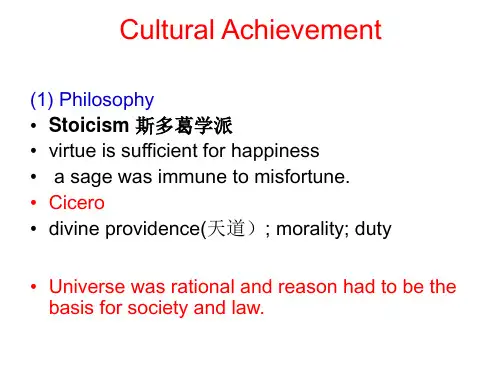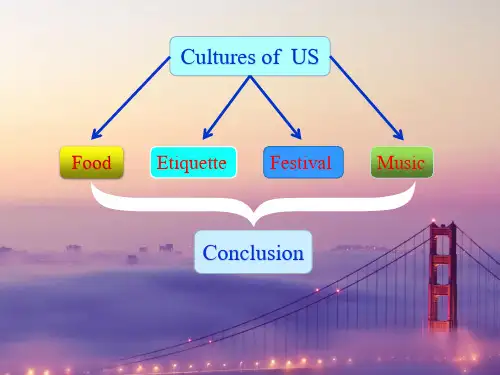西方文化英文简介课件
- 格式:pdf
- 大小:3.13 MB
- 文档页数:25

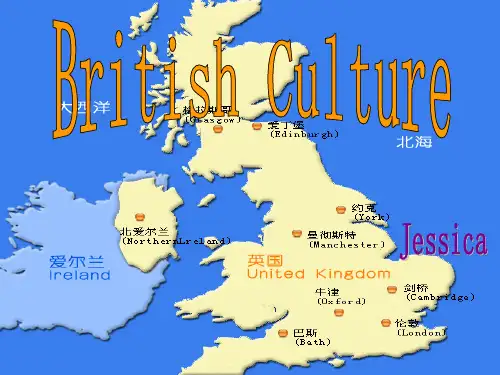




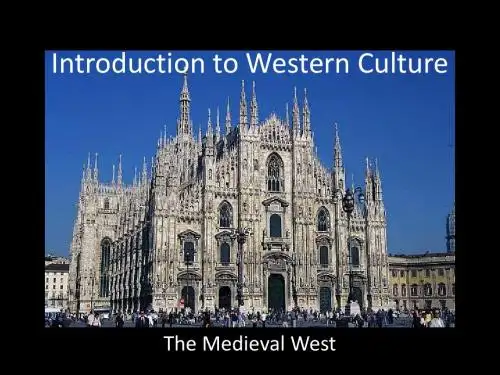
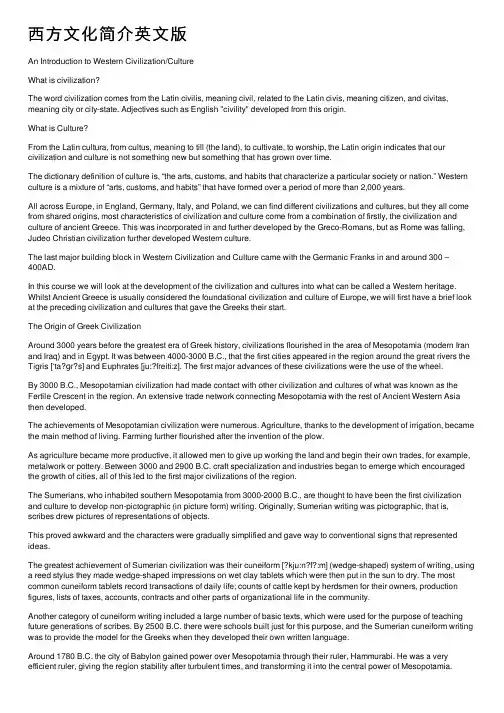
西⽅⽂化简介英⽂版An Introduction to Western Civilization/CultureWhat is civilization?The word civilization comes from the Latin civilis, meaning civil, related to the Latin civis, meaning citizen, and civitas, meaning city or city-state. Adjectives such as English "civility" developed from this origin.What is Culture?From the Latin cultura, from cultus, meaning to till (the land), to cultivate, to worship, the Latin origin indicates that our civilization and culture is not something new but something that has grown over time.The dictionary definition of culture is, “the arts, customs, and habits that characterize a particular society or nation.” Western culture is a mixture of “arts, customs, and habits” that have formed over a period of more than 2,000 years.All across Europe, in England, Germany, Italy, and Poland, we can find different civilizations and cultures, but they all come from shared origins, most characteristics of civilization and culture come from a combination of firstly, the civilization and culture of ancient Greece. This was incorporated in and further developed by the Greco-Romans, but as Rome was falling, Judeo Christian civilization further developed Western culture.The last major building block in Western Civilization and Culture came with the Germanic Franks in and around 300 –400AD.In this course we will look at the development of the civilization and cultures into what can be called a Western heritage. Whilst Ancient Greece is usually considered the foundational civilization and culture of Europe, we will first have a brief look at the preceding civilization and cultures that gave the Greeks their start.The Origin of Greek CivilizationAround 3000 years before the greatest era of Greek history, civilizations flourished in the area of Mesopotamia (modern Iran and Iraq) and in Egypt. It was between 4000-3000 B.C., that the first cities appeared in the region around the great rivers the Tigris [‘ta?ɡr?s] and Euphrates [ju:?freiti:z]. The first major advances of these civilizations were the use of the wheel.By 3000 B.C., Mesopotamian civilization had made contact with other civilization and cultures of what was known as the Fertile Crescent in the region. An extensive trade network connecting Mesopotamia with the rest of Ancient Western Asia then developed.The achievements of Mesopotamian civilization were numerous. Agriculture, thanks to the development of irrigation, became the main method of living. Farming further flourished after the invention of the plow.As agriculture became more productive, it allowed men to give up working the land and begin their own trades, for example, metalwork or pottery. Between 3000 and 2900 B.C. craft specialization and industries began to emerge which encouraged the growth of cities, all of this led to the first major civilizations of the region.The Sumerians, who inhabited southern Mesopotamia from 3000-2000 B.C., are thought to have been the first civilization and culture to develop non-pictographic (in picture form) writing. Originally, Sumerian writing was pictographic, that is, scribes drew pictures of representations of objects.This proved awkward and the characters were gradually simplified and gave way to conventional signs that represented ideas.The greatest achievement of Sumerian civilization was their cuneiform [?kju:n?f?:m] (wedge-shaped) system of writing, using a reed stylus they made wedge-shaped impressions on wet clay tablets which were then put in the sun to dry. The most common cuneiform tablets record transactions of daily life; counts of cattle kept by herdsmen for their owners, production figures, lists of taxes, accounts, contracts and other parts of organizational life in the community.Another category of cuneiform writing included a large number of basic texts, which were used for the purpose of teaching future generations of scribes. By 2500 B.C. there were schools built just for this purpose, and the Sumerian cuneiform writing was to provide the model for the Greeks when they developed their own written language.Around 1780 B.C. the city of Babylon gained power over Mesopotamia through their ruler, Hammurabi. He was a very efficient ruler, giving the region stability after turbulent times, and transforming it into the central power of Mesopotamia.A great literary revival followed Babylonian independence. One of the most important works of this era of Babylon was the writing of the first known code of laws called the ‘Code of Hammurabi.’ It focused on theft, farming (or shepherding), property damage, women’s righ ts, marriage rights, children’s rights, slave rights, murder, death, and injury. The punishment is different for different classes of offenders and victims.The city of Babylon also features in the Judeo Christian tradition. A story in the Bible is used by Jews and Christians to explain the existence of many different languages and races in the world. According to the biblical book of Genesis 11, at Babylon, humanity began building a ‘Tower of Babel’ in order to reach heaven and gain access to heaven directly from earth without the need of God. To prevent the project from succeeding, God made all the workers speak different new languages so that they could no longer communicate with one another and the work could not proceed, after that time, the people moved away to different parts of Earth, and spoke the different languages they had been given by God.From this story, and the city of Babylon, comes the modern English word babble, or talk in a confusing way. It is also due to the Babylonians that we have 60 seconds in a minute and 60 minutes in an hour. The mathematicians of Babylonia devised a system of counting based on the number 60, from which we get the number of seconds in a minute and of minutes in an hour and the number of degrees (60×6=360) in a circle. Mesopotamia ceased to be a major power after the conquest by Alexander the Great around 400 B.C.While the Sumerians and other groups were busy creating a Mesopotamian civilization, another civilization had appeared to the west. This civilization depended entirely on geography; it was the fertile valley of the Nile River that allowed Egyptian civilization to flourish over the course of many centuries.The art and science of engineering was greatly developed in Egypt, with their skill in surveying allowing them to accurately determine the position of points and the distances between them. These skills were used to outline the bases of the best known images of Ancient Egypt, the pyramids. The first pyramids, built around 2900 B.C., were little more than mud-brick structures, but the greatest building achievements in Egypt were the great pyramids of Giza, built more than 4500 years ago. The early civilizations of Mesopotamia and Egypt certainly could build pyramids, irrigation canals and pottery wheels, and develop cuneiform writing. They are not, however, considered the foundation of civilization and culture of Europe. Although civilization developed in the fertile crescent of Mesopotamia, it was in the civilizations bordering the Mediterranean that Western civilization and culture was truly born. It is the civilization and culture of Ancient Greece that is today seen as being the origin of Western civilization and culture.Ancient Greece is considered by most historians to be the foundational civilization and culture of Western civilization. Ancient Greek civilization has been immensely influential on the language, politics, educational systems, philosophy, art and architecture of the modern Western world.The period of Greek domination of the Mediterranean world lasted approximately 1,500 years from around 1600 BC until the coming of the Roman Empire, it should be noted, that we should not consider it to be one long uninterrupted rule, or that the Greeks were one group.The History of Greek CivilizationAegean Civilization3000-1450BC Minoan Civilization2000BC People from Mycenae went to Greece1600-1200BC Mycenae Civilization Ruled Greece1200-800BC Dark Period for Greece800-490BC The Archaic Period490-336BC The Classical Period336-30BC The Hellenistic Period146BC Greece was incorporated into RomeThe Rise and fall of Mycenaean PowerAt the height of its power, it was prosperous and active. They enlarged their cities, expanded their trade and sacked Troy. It was gone in 1100BC after the Troy War. The period from 1600 BC to about 1100 BC is known as Mycenaean [maisi?ni:?n] Greece after the major city of the period Mycenae.The age of Mycenae has given us the epic poem that has had a profound effect on the body of western literature and art. Transmitted to us through the Romans, the Renaissance and the following generations, this is the work of one author, the man who gave us the story about Troy.The period from which the story came, Mycenaean Greece, ended around 1100 BC, and the period from 1100 BC to around 800 BC is a ‘dark age’ of which little is known. In 800 BC Greece began to emerge from these Dark Ages, and at this time a written record begins to appear. This is the period most consider Classical Greece, but in those days there was no such political unit known as Greece. Greek geography, where every island, valley and plain is cut off from its neighbours by the sea or mountain ranges, dictated that Greece was divided into many small self-governing city communities.。
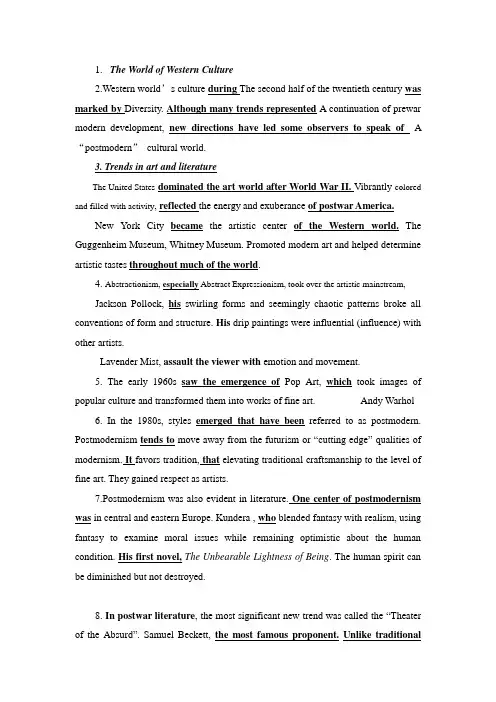
1.The World of Western Culture2.Western world’s culture during The second half of the twentieth century was marked by Diversity. Although many trends represented A continuation of prewar modern development, new directions have led some observers to speak of A “postmodern”cultural world.3. Trends in art and literatureThe United States dominated the art world after World War II. Vibrantly colored and filled with activity, reflected the energy and exuberance of postwar America.New York City became the artistic center of the Western world.The Guggenheim Museum, Whitney Museum. Promoted modern art and helped determine artistic tastes throughout much of the world.4. Abstractionism, especially Abstract Expressionism, took over the artistic mainstream,Jackson Pollock, his swirling forms and seemingly chaotic patterns broke all conventions of form and structure. His drip paintings were influential (influence) with other artists.Lavender Mist, assault the viewer with emotion and movement.5. The early 1960s saw the emergence of Pop Art, which took images of popular culture and transformed them into works of fine art. Andy Warhol6. In the 1980s, styles emerged that have been referred to as postmodern. Postmodernism tends to move away from the futurism or “cutting edge” qualities of modernism. It favors tradition, that elevating traditional craftsmanship to the level of fine art. They gained respect as artists.7.Postmodernism was also evident in literature. One center of postmodernism was in central and eastern Europe. Kundera , who blended fantasy with realism, using fantasy to examine moral issues while remaining optimistic about the human condition. His first novel,The Unbearable Lightness of Being. The human spirit can be diminished but not destroyed.8. In postwar literature, the most significant new trend was called the “Theater of the Absurd”. Samuel Beckett, the most famous proponent.Unlike traditionaltheater, suspense is maintained not by having the audience wonder “What is going to happen next?” but simply “What is happening now”.9. The sense of meaninglessness also underscored the philosophy of existentialism. Albert Camus and Jean Paul Sartre. The starting point of the existentialism of Sartre and Camus was the absence of God in the universe. It meant that humans had no preordained destiny and were utterly alone in the universe, with no future and no hope. Reduced to despair and depression, humans have but one ground of hope----themselves.10.The Revival of ReligionA number of religious thinkers and leaders attempted to bring new life to Christianity in the twentieth century.Karl Barth infuses traditional Christian teachings with new life. To Barth, the sinful and hence imperfect nature of human beings meant that humans could know religious truth not through reason but only through the grace of God.11. In the Catholic church,attempts at religious renewal came from two charismatic popes---- John XXIII and John Paul II.John XXIII sparked a dramatic revival of Catholicism when he summoned the twenty-first ecumenical council of the Catholic church. The Mass was celebrated in the vernacular languages rather than Latin.John Paul II . Although he alienated a number of people by reasserting traditional Catholic teaching on such issues as birth control, women in the priesthood, and clerical celibacy, John Paul’s numerous travels around the world helped strengthen the Catholic church throughout the non-western world.12. The New World of Science and TechnologyMany of the scientific and technological achievements since World War II have revolutionized people’s lives.During the war, university scientists were recruited to work for their governments and develop new weapons and practical instruments of war.British physicists played an important role in an improved radar system that helped defeat the German air force in the Battle of Britain.German scientists created self-propelled rockets as well as jet airplanes to keep Hitler’s hopes alive for a miraculous turnaround in the war.13.The most famous product of wartime scientific research was the atomic bomb, created by a team of American and European scientists under the guidance of the physicist J. Robert Oppenheimer. The computer may yet prove to be the most revolutionary of all the technological inventions of the twentieth century. The British mathematician Alan Turing designed a primitive computer to assist British intelligence in breaking the secret codes of German ciphering machines. Early computers required thousands of vacuum tubes to function, large and took up considerable space. The development of the transistor and the silicon chip.In 1971, the microprocessor, combines the equivalent of transistors on a single, tiny silicon chip, opened the road for the development of the personal computer.14. By 2000, the personal computer had become a regular fixture in businesses, schools, and homes. The Internet----the world’s largest computer network----provides millions of people around the world with quick access to immense quantities of information. The computer make a whole host of tasks much easier, but it has also become an important tool in modern life.In the 1960s and 1970s some people believed that some technological advances had far-reaching side effects damaging to the environment. The threat of global warming and dwindling of forests and lakes made environmentalism one of the important issues of the early twenty-first century.15. The Explosion of Popular CultureSince World War II, popular culture has played an increasingly important role in helping Western people define themselves.The history of popular culture is also the history of the economic system thatsupports it.16. Popular culture and the Americanization of the worldThe United States has been the most influential force in shaping popular culture in the West. Through movies, music, advertising, and television, the United States has spread its particular form of consumerism and the American dream to millions around the world. In movies, televisions, and music, the impact of American popular culture on the Western world is pervasive. “T he film is to America what the flag was once to Britain.”17. Motion pictures were the primary vehicle for the diffusion of American popular culture. Dominate both European and American markets. In the 1960s, as television spread around the world, American networks sold their products in Europe and the Third World at extraordinarily low prices. The United States has also dominated popular music since the end of World War II. All of them originated in the United States, and all are rooted in African American musical innovations. These forms later spread to the rest of the world, inspiring local artists who then transformed the music in their own way. The establishment of the video music channel MTV in the early 1980s changed the music scene by making image as important as sound to the selling of records.18. In the postwar years, sports have become a major product of both popular culture and the leisure industry. The development of satellite television and various electronic breakthroughs helped make sports a global phenomenon.19. Toward a Global Civilization?Increasingly, people are becoming aware of the political and economic interdependence of the world’s nations and the global nature of our contemporary problems. At the beginning of the twenty-first century, human beings are coming to understand that destructive forces unleashed in any part of the world. Nuclear proliferation means radioactive fallout for the planet.20. Smokestack pollution can produce acid rain. Oil spills and dumping of wastes. The consumption of drugs affects the stability of both wealthy and less developed nations. In reflection on the terrorist crisis, “how fragile are our frontiers inthe fact of the world’s new challenges.”Terrorism is an important example as international terrorist groups seek to wreak havoc around the world.21. One approach has been to develop grassroots social movements, including those devoted to the environment, women’s and men’s liberation, human potential, appropriate technologies, and nonviolence. “Think globally, act locally” is one slogan these groups use. The growth of non-governmental organizations (NGOs), NGOs are an important instrument in the cultivation of global perspectives. Include professional, business, and cooperative organizations; foundations; religious, peace, and disarmament groups; youth and women’s organizations; environmental and human rights groups; and research institutes.22. Yet hopes for global approaches to global problems have also been hindered by political, ethnic, and religious disputes. Pollution of the Rhine River by factories along its banks provokes angry disputes among European nations. The Unite States and Canada have argued about the effects of acid rain on Canadian forests. The collapse of the Soviet Union and its satellite system between 1989 and 1991 seemed to provide an enormous boots to the potential for international cooperation on global issues; Led to the emergence of squabbling new nations and an atmosphere of conflict and tension throughout much of Eastern Europe. The bloody conflict in the former Yugoslavia clearly indicates the dangers in the rise of nationalist sentiment among various ethnic and religious groups in Eastern Europe. Even as the world becomes more global in culture and interdependent in its mutual relations, centrifugal forces are still at work attempting to redefine the political, cultural, and ethnic ways in which the world is divided.Many lessons can be learned from the history of Western civilization, an understanding of our Western heritage and its lessons can be instrumental in helping us create new models for the future. For we are all creators of history, and the future of Western and indeed world civilization depends on us.ResumeName: Dong YiAddress:Bldg.No.15, Rm.209, China University of Geosciences, XueYuan Road, HaiDian District, Beijing, 100083Date of Birth: December 15, 1991Sex: FemaleMarital status: SingleHealth: ExcellentEducation:2007-2010 Petroleum Middle School, Beijing2010-2014 China University of Geosciences, BeijingMajor: EnglishReceived B.A. in English, July 2014Work experience:2008 V olunteer for cleanerOlympic Park Environmental ProtectionAwards and Scholarships:2009-2010 “Excellent Student”, Petroleum Middle School2010 “Bridge Design Award”, Petroleum Middle SchoolInterests: Travel, dancing, swimmingReferences: Available upon request。
